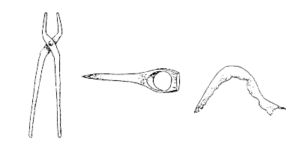NCERT Solutions Class 6 Social Science (History)
The NCERT Solutions in English Language for Class 6 Social Science (History) Chapter – 8 (Vital Villages, Thriving Towns) has been provided here to help the students in solving the questions from this exercise.
Chapter – 8 (Vital Villages, Thriving Towns)
Let’s Recall
1 Fill in the blanks:
(a) _______ was a word used for large landowners in Tamil.
(b) The grambhojaka often got his land cultivated by the_____.
(c) Ploughmen were known as_____ in Tamil.
(d) Most grihapatis were _____ landowners
Answer –
(a) Vellalar was a word used for large landowners in Tamil.
(b) The grambhojaka often got his land cultivated by the Slaves and workers.
(c) Ploughmen were known as Uzhavar in Tamil.
(d) Most grihapatis were Smaller landowners
2. Describe the functions of the grambhojka. Why do you think he was powerful?
Answer – The Grambhojaka was powerful because he was the largest landowner and he had direct contact with the king as he collected taxes for him from the villages.
3. List the crafts persons who would have been present in both villages and cities.
Answer – Craftsmen such as blacksmith, weavers, carpenters and potters were present in both villages and cities.
4. Choose the correct answer:
(a) Ring wells were used for:
1. Bathing
2. Washing clothes
3. Irrigation
4. drainage
(b) Punch marked coins were made of:
1. Silver
2. Gold
3. Tin
4. Ivory
(c) Mathura was important:
1. Rulers
2. Craftspersons
3. Religious centre
4. Forested area
(d) Shrenis were associations of:
1. Rulers
2. Craftspersons
3. Farmers
4. Herders
Answer –
(a) Ring wells were used for: – 4. Drainage
(b) Punch marked coins were made of: – 1. Silver
(c) Mathura was important: – 3. Religious centre
(d) Shrenis were associations of: – 2. Craftspersons
Let’s Discuss
5. Which of the iron tools shown on page 79 (of the NCERT textbook) would have been important for agriculture? What would the other tools have been used for?
Answer – The iron tools on page 79 are tongs, axes and sickle as shown in the picture below, respectively.
 Sickle would have been important for agriculture because it should be used for cutting grass and crops. The other tools like axes for clearing forests arid the iron plough shore for increasing agricultural production.
Sickle would have been important for agriculture because it should be used for cutting grass and crops. The other tools like axes for clearing forests arid the iron plough shore for increasing agricultural production.
6. Compare the drainage system in your locality with that of the cities mentioned in the lesson. What similarities and differences do you notice?
Answer – In our locality each house have good drainage system. There is underground drainage system with covered drams. The ancient cities had ring- well system. It is a rows of pots or ceramic rings arranged one on top of other. They have been used as toilet in some areas and as drains and garbage lumps. These ring wells have been found in individual houses.
NCERT Class 6 – History (Our Pasts – I)
- Chapter 1 – What, Where, How and When?
- Chapter 2 – From Hunting – Gathering to Growing Food
- Chapter 3 – In the Earliest Cities
- Chapter 4 – What Books and Burials Tell Us
- Chapter 5 – Kingdoms, Kings and an Early Republic
- Chapter 6 – New Questions and Ideas
- Chapter 7 – Ashoka, The Emperor Who Gave Up War
- Chapter 9 – Traders, Kings and Pilgrims
- Chapter 10 – New Empires and Kingdoms
- Chapter 11 – Buildings, Paintings, and Books

Leave a Reply